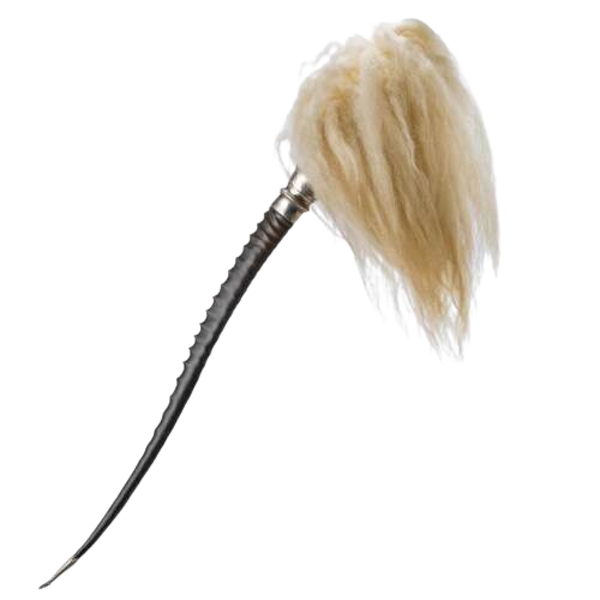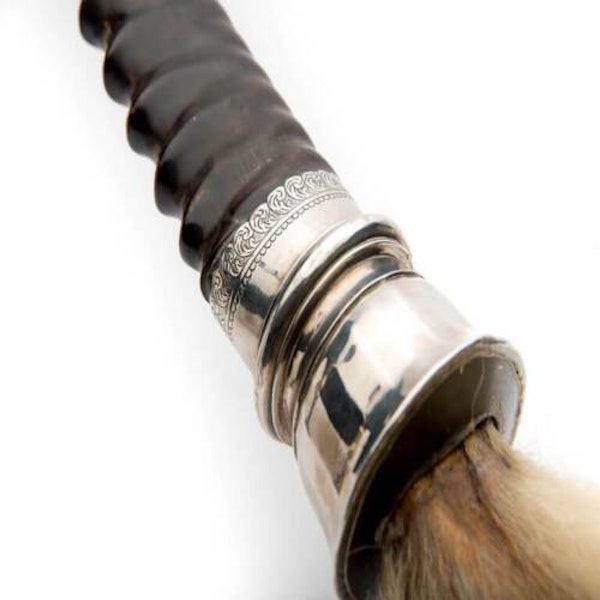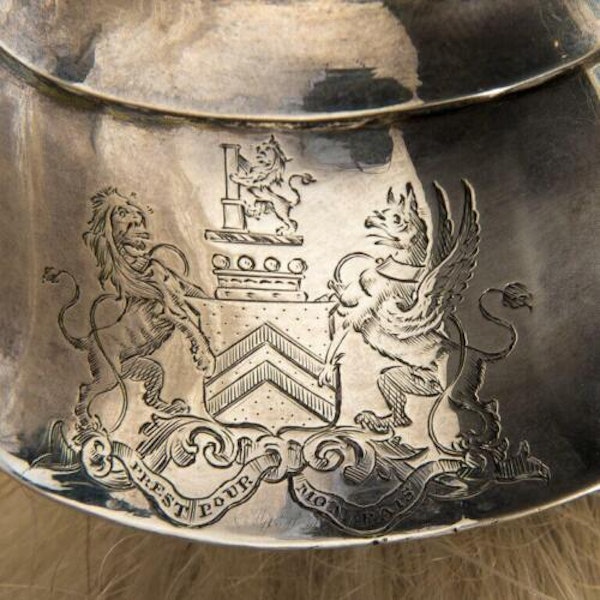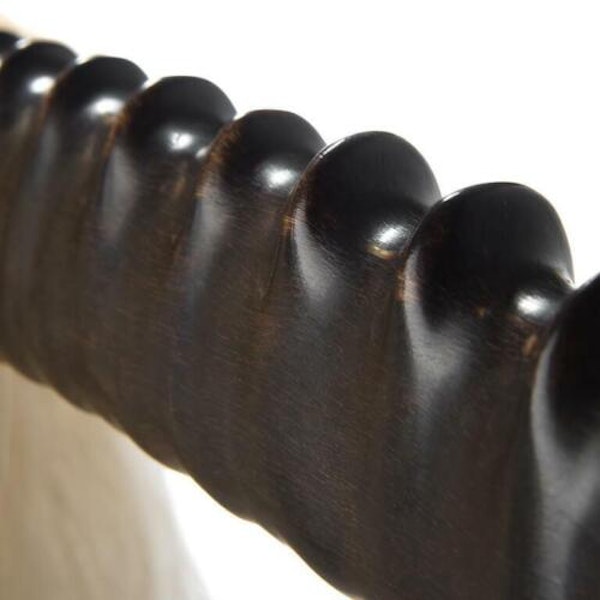Antique Indian Colonial Silver, Horn & Yak Tail Fly Whisk, India – 1728-1800
Antique Indian Colonial Silver, Horn & Yak Tail Fly Whisk, India – 1728-1800
£3,750.00
Description
PRODUCT DESCRIPTION
An unusual antique Indian colonial silver antelope horn and yak tail hair fly whisk (chowry), finely engraved with a decorative border and the armorial crest of the distinguished Monson (pronounced Munson) family of Burton, Lincolnshire and bearing their motto, ’ Prest Pour Mon Pais’, which translates as ‘ready for my country’. The armorial features a baronial crown which dates the whisk to after 1728, the year in which George I created the peerage.
According to the description of a 19th century Indian fly whisk within the collection of London's V & A Museum, fly whisks with "..... a plume of yak tail hair in an elaborate holder - are the most frequently used and depicted emblems of royalty. Chauri are swayed on either side of the ruler by dedicated officials called chamardar. Chauri derives from the Sanskrit word chamara, meaning fly-whisk, which is extremely close to the word for 'yak'."
The horn is believed to have come from a large male Chinkara or Indian gazelle (Gazella bennettii) which is native to India, Pakistan and Iran. The ringed horns of the male, normally 15 to 25 rings, appear almost straight when seen from the front but in profile take a lightly ‘S’ shaped curve.
The whisk’s silver mount is unmarked but the high quality of engraving on the armorial suggests it was made by a colonial silversmith working in one of the principal colonial silver manufacturing centres, Madras and Calcutta at this time, most likely Madras, where William, George and William John Monson are all known to have resided – although it is not known which of the three purchased the whisk.
The Monson family’s association with India spanned the period from 1725 until 1800 and the fly whisk (chowry) would have been purchased in India after 1728 as a necessary deterrent to the unwelcome attention of flies, particularly during the intense summertime heat.
William Monson was the first member of the family to travel to India. He went in 1725 with £1,000 initial capital from his father which he transported as silver bullion, converting it into pagodas (the South Indian currency) upon arrival. William Monson worked for the East India Company at Fort St George, Madras and served as Sheriff of Madraspatnam (Madras) in the year 1734. As was common practice at this time, he was also trading on his own account, assisted by his brother in London, whilst working for the East India Company in Madras. After several hiccups he started to make some money but lost most of it after the Battle of Madras when the French occupied Madras and confiscated several private warehouses, including Monson’s, following the defeat of the British garrison. William left India and returned home to England in 1747, leaving behind four horses, (which would have been extremely expensive and probably imported from Persia), and his two faithful servants who had been with him for the twenty-two years since his arrival in India.
William’s nephew, Sir John Monson, 1st Baron Monson of Burton, was created a peer of the realm by George I in 1728. He was a Privy Councillor and was appointed the first Commissioner of Trade and Plantations in 1737, what would now be termed, President of the Board of Trade.
In 1758, Major George Monson (1730-1776), his youngest son, who was also the grandson of the Earl of Rockingham, sailed to India with the Draper’s Regiment. The previous year, George had married a widow four years older than himself, Lady Anne Hope-Vere, the daughter of the Earl of Darlington and a great grand-daughter of King Charles II. George Monson and his wife both hailed from aristocratic and very well connected families and George held a position at Court as Groom of the Bedchamber of George, Prince of Wales, keeping this position after the Prince succeeded to the throne and became King George III. George Monson was elected a Member of Parliament for Lincoln in 1754. Re-elected in 1761, he retained his seat until 1768.
When he arrived in India, George travelled to Bombay and Madras before distinguishing himself during the siege of Pondicherry in 1760, after which he was promoted to lieutenant colonel. He had been seriously wounded but recovered and in 1761 was given command of the 96th foot, distinguishing himself during action in the capture of Manila in 1762 after which he was promoted again; attaining the rank of brigadier-general in 1763. After the Peace of Paris he returned to England and in 1769 he became a full colonel and aide-de-camp to King George III, who is reported to have said about him that ‘though not a strong man he had excellent brains’!
Appointed to the Supreme Council of Bengal in the Regulating Act of 1773, Monson returned to Calcutta again in 1774 with his wife, Lady Anne. George and Anne became active and prominent figures in Calcutta society. A contemporary diarist, Macrabie, described Anne as ‘a very superior whist-player’ but she was already very well known to those in the botanical and scientific community as an exceptional botanist, plant and insect collector.
George is best remembered for his staunch, almost immediate opposition to the policies of the Governor General, Warren Hastings and to the Judges of the Supreme Court, particularly in the affair of the Maharaja of Nandakumar (Nuncomar) in which he was particularly active. He was made Colonel of the 50th foot on 1st Sept. 1775. Since his return to Calcutta, George had been plagued by illness and following the death of his wife Anne, in February 1776, he resigned from the Supreme Council intending to return to England but died shortly afterwards in Calcutta in September 1776. Before the news of his death reached England, George had been promoted further, this time to the rank of Lieutenant-General.
Anne’s contemporary, J E Smith, claimed that it was Lady Anne who had assisted James Lee in translating Linnaeus’s Philosophia Botanica, the first work to explain the Linnaean classification to English readers. Lee published the book under his own name in 1760, acknowledging Lady Anne anonymously in the preface. A few years later, Anne was introduced to the Danish entomologist, Johan Christian Fabricius, one of Linnaeus’s pupils. Anne was also mentioned by James Lee in his letters to Linnaeus.
In 1774, on her voyage out to Calcutta, Lady Anne had visited the Cape of Good Hope where she met Carl Peter Thurnberg, a pupil of Linnaeus and a seasoned collector of South African plants. She accompanied Thurnberg on several plant hunting expeditions around Cape Town, presenting him with a ring in remembrance of her visit. One of the South African plants collected by Lady Anne was a flowering shrub, later named ‘Monsonia’ in her honour by Carl Linnaeus. It is said that Anne and Linnaeus never met but were great correspondents. Specimens of Monsonia were sent to Kew Gardens in 1774.
Major Hon. William Monson (1760-1807), was the third member of the family to go to India. He was the son of the 2nd Baron Monson of Burton and George Monson’s nephew. He also had a distinguished service career in the Indian army, becoming a major of the 52nd foot in 1795 and lieutenant-colonel of the 76th Foot in 1798. His son, William John Monson, was born in Madras in 1796 whilst his father was stationed there. The family returned to England around 1800 and the Hon. William became the Member of Parliament for Lincoln until his death in 1807. As far as we have been able to ascertain, 1800 was the date at which the Monson family’s involvement with India ended.
When the childless Frederick, 5th Baron Monson of Burton, died in 1841, William John Monson, Frederick’s second cousin, succeeded to the title and inherited the estates of Gatton and Burton, becoming 6th Baron Monson of Burton. William was already married to Eliza Larken, whose father had served in India at a similar time to his own, whilst working as a tea trader with the East India Company.
The Monson family continued to prosper as an important Lincolnshire family and continue to be very active in politics and diplomacy up to the present day. The 7th Baron, a notable Liberal politician, was created Viscount Oxenbridge in 1886. His brother, Sir Edmund Monson, had a glittering diplomatic career in South America and Europe, serving as British Ambassador to Austria from 1893 to 1896 and France from 1896 to 1904. In gratitude for his service, he was created a Baronet in his own right in 1905. The present incumbent, Nicholas, the 12th Baron Monson, is campaigning for female equality in the inheritance of hereditary peerages.
An Indian silver mounted horn and horsehair fly whisk is within the collection of the Islamic Arts Museum in Kuala Lumpur.
Provenance: UK Art Market
| item details | |
|---|---|
| Origin | Asian |
| Period | 19th Century |
| Style | Other |
| Condition | Excellent |
| Dimensions | Length of Handle: 72 cms |
Product REF: 10025








